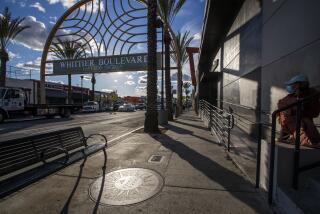Follow the Highway to a Better Urban Policy : Growth: Cisneros at HUD and Pena at transportation could be the dynamic duo that used transit money to bring economic prosperity to cities.
- Share via
VENTURA — The Clinton Administration is trying to look as if it is doing something about America’s inner cities. This weekend, Bill Clinton was scheduled to meet with several Cabinet mem bers at Camp David to craft an integrated urban agenda. Exhibit No. 1, says Henry Cisneros, the new secretary of housing and urban development, would be South-Central Los Angeles. He hopes to use the Administration’s efforts there as a model.
It remains to be seen whether a moderate President hoping to appeal to a suburban constituency will pay serious attention to urban issues. But the potential for coordinated federal action is especially propitious--because while Cisneros, the former mayor of San Antonio, warms the HUD chair, his old friend Federico Pena, the former mayor of Denver, is settling in at transportation.
Cisneros and Pena were key figures in the Reagan-era movement toward more economic self-reliance among struggling large cities. They rejected the Great Society solution of groveling in Washington for more federal aid, though they did seek large grants for specific economic- development projects. Instead, they tried to help their cities “grow their own” economic prosperity.
Today, the two share an opportunity to redirect federal urban policy, for the first time, toward the root causes of inner-city decay. To achieve this, they must develop a “metropolitan policy,” one that recognizes Washington’s profound influence in shaping metropolitan growth patterns and fueling suburban sprawl.
Federal transportation and mortgage policies, for example, are often blamed for “white flight” in the postwar era. And though Washington plays a less important role today, federal money--especially transportation funds--still goes a long way toward determining the shape and pattern of metropolitan areas. These patterns, in turn, help shape private investment decisions. The more the feds promote suburban sprawl through their own decisions, the more suburban sprawl becomes a reality on the ground in metropolises like Southern California, sucking investment out of the inner city. This trend has continued unabated for almost 50 years, and “white flight” has been replaced by a rainbow coalition of working-class people deserting the cities.
No urban leader understands these influences better than Cisneros. He is a believer in the leading theory among city-governance dweebs in the 1980s: Central cities are not merely social-service agencies or trash collectors; they also are engines of a region’s economy and prosperity. As such, central-city governments can be used to stimulate certain kinds of economic growth. Reflecting this view, Cisneros’ urban strategy will probably employ a range of federal incentives to encourage prosperity in inner cities, including traditional housing subsidies and tax breaks for businesses.
But true political clout requires money and, thanks to Reagan-era budget cuts, Cisneros doesn’t have much at HUD. So here is where Pena becomes important.
At transportation, Pena will spend most of his time dealing with airlines, trucking, shipping and highway safety. But he’ll also be in charge of Washington’s biggest pot of infrastructure gold--the $150-billion surface-transportation vault. This fund is one of George Bush’s few domestic legacies, and it’s exactly the kind of program Clinton has advocated to get the economy moving again.
Whether the transportation money can jump-start the economy in the short term is questionable. But there’s no question the money is the single most important federal presence in metropolitan planning. The transportation projects financed--highways, transit systems, etc.--will determine where future business investment will occur. Put those projects in the suburbs, and you’ll likely fuel a further decentralization of jobs. Put those projects in older communities, and you might induce a few of those jobs to stay put. Most federal “urban policy” ideas are a drop in the bucket compared with the power of federal transportation funds to shape and steer investment decisions.
Take, for example, the three proposed tollways in Orange County. They will largely be built with local toll revenue, but approval from the Federal Highway Administration is being sought so that Washington money can be used if necessary. The Orange County Transportation Corridor Agencies, the public entity constructing the tollways, has been promoting the roads as Clinton-style infrastructure investment, even to the point of taking out newspapers ads featuring Clinton’s photograph. Yet the major purpose of the tollway will be to facilitate travel in the newly developing and mostly affluent suburbs of south Orange County, hardly a useful urban policy.
Last spring’s unrest in Los Angeles reminded many transportation experts that most jobs have become out of reach for inner-city residents even when they’re qualified for them. While L.A. light-rail line has improved service between South-Central and downtown, UCLA researchers recently concluded that east-west bus service--far more critical for access to most job centers--remains as lousy as ever, further isolating inner-city residents from jobs. As with the tollways, the L.A. rail system is being built partly with local funds, but federal transportation money is also involved.
Thus, a high-minded statement of urban strategy from Cisneros won’t do the country much good unless it’s backed up by a wide-ranging federal policy that encompasses decisions at other departments, and especially at Pena’s.
Yet, there are three potential obstacles to a sound urban policy. First, it might be difficult to persuade Clinton that infrastructure money should serve a social agenda, rather than being plowed into the economy as quickly as possible. Second, since the President downplayed urban problems in his campaign to woo suburban voters, he may not be politically motivated to take on inner-city decay. Finally, though both are Latino, Cisneros and Pena are essentially crossover politicians who have constituencies in the suburbs as well as in the cities.
But Cisneros’ and Pena’s appeal across racial lines may help overcome some of the political barriers to a thoughtful federal policy on the inner cities. Thanks to the images of South Los Angeles, it may be possible to get the case for strong inner-city policies across to suburban constituencies. Indeed, given the moribund state of the L.A. economy, the argument that cities must be nurtured because they are the engines of regional economies might prevail in suburbia.
For decades, selling the suburbs on the cities has been one of the toughest political tasks. That’s why suburbs keep growing and cities keep decaying and administrations keep ignoring the problem. But Cisneros and Pena should use their access to the President to reverse these longstanding trends.
More to Read
Sign up for Essential California
The most important California stories and recommendations in your inbox every morning.
You may occasionally receive promotional content from the Los Angeles Times.










